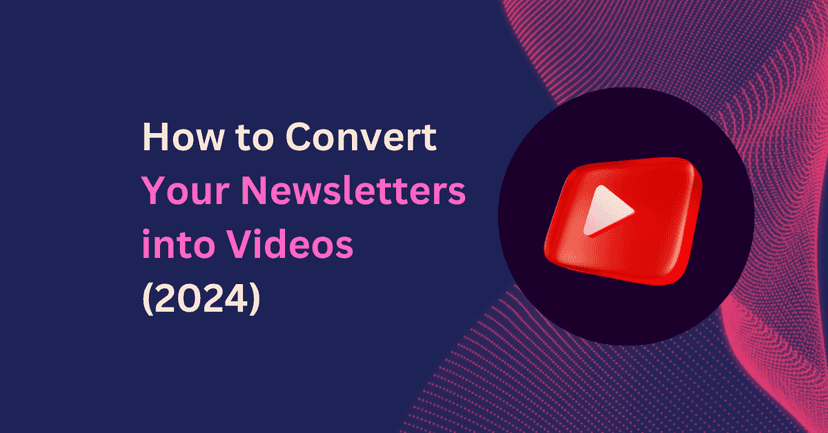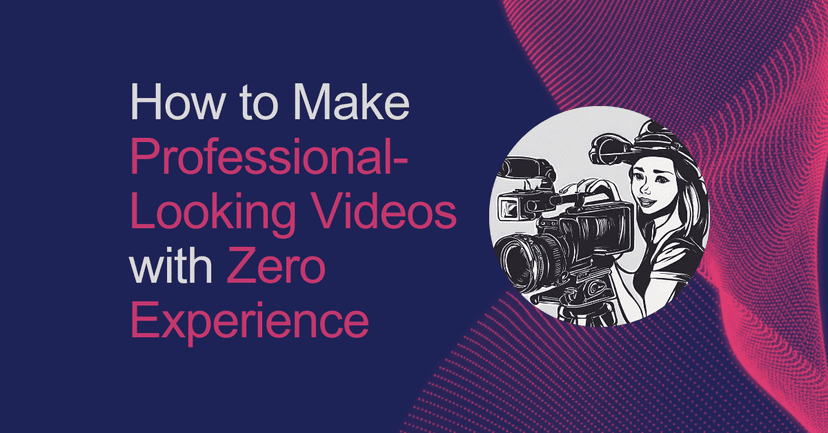
How to Make Educational Videos for Your Non-Profit
Do you know how to make educational videos for your non-profit organization? More importantly, why should you create one? Learn more in today's article!
Nearly three and a half billion internet users watch videos on their mobile phones and other devices.
The numbers could be higher.
The point is that everyone and anyone can leverage videos’ massive reach, including non-profit organizations.
And if you couple this with social media platforms, you will know that well-crafted educational videos for non-profit organizations are the way to go.
But do you know how to make educational videos for your non-profit organization? More importantly, why should you create one?
Sit back and learn how to produce the most mesmerizing and informative videos for your non-profit’s audiences.
What Are Educational Videos for Non-Profit?

As the name suggests, educational videos for non-profit entities are visual tools that spread information about a charitable or socially responsible organization’s efforts.
It can give a much-needed boost to fundraising activities, improve engagement, and widen the support base.
Like other video types, nonprofit educational videos seek to inform audiences and the general public about an organization’s worthy cause.
They can highlight program initiatives and campaigns, allowing more people with similar beliefs to join and support the nonprofit entity.
A compelling story is at the heart of effective informative videos for nonprofits, made more engaging by an equally evocative narrative, sound, and visuals.
Nonprofit informative videos touch the heart more effectively than marketing and sales campaigns.
Interesting Read: 7 Benefits of Using AI Tools for Students
Why Should You Create Educational Videos for Your Non-Profit Organization?

Although educational nonprofit videos have nearly identical benefits as other informative visuals, they offer several distinct advantages. No socially responsible organization should miss the following pluses.
Reach a wider audience
As mentioned, nearly 3.5 billion people watch videos.
And get this!
Over four billion people use smartphones and tablets to surf the net. Fifty-seven to seventy-five percent watch videos on mobile devices.
Suppose you target a quarter of this population.
Your nonprofit organization will still get around a billion potential audiences.
That’s huge! A wider audience translates to more opportunities to advance your group’s cause. You can help more people, communities, special needs groups, and other entities.
Videos are more engaging
Did you know that over four in five individuals would ditch reading for watching? That’s unsurprising. Our brains process visual information up to 60,000 times more efficiently than printed words.
Give two individuals two identical materials but in different formats.
One is pure text, while the other is a stunning video. Which consumer will you expect to show a more profound reaction?
For example, an educational video featuring talking heads or virtual avatars can make viewers smile (or even giggle) at the funny antics.
Try the same material with plain text. Would you get the same reaction?
Interesting Read: Top 7 AI Tools For Teachers [2024]
Establish and reinforce emotional connections
Neuroscientists say visuals directly connect to the amygdala – the brain’s emotional center.
So, if an AI avatar delivers an emotional plea to help or support a nonprofit organization’s social amelioration efforts, you can expect viewers to feel the pinch.
But wait!
Don’t we use our eyes to read, too?
You’re right. But written words pass through another part of the brain for initial processing before they reach the amygdala.
This “detour” or “stopover” makes reading text less emotionally powerful than videos.
This observation makes generative AI videos a powerful tool for nonprofit organizations to inform and educate the public about their vision and campaigns.
After all, moving people is easier if you talk to their hearts and souls.
Enhances fundraising drives
AI educational videos can help nonprofits boost their fundraising campaigns.
You will reach more people, giving you more opportunities to lay out your case. The more people agree to the information shared, the more people are willing to help.
The good news is that increasing nonprofit support also boosts the number of people receiving help.
Your organization can feed more hungry and starving children, build more homes for the homeless, find more jobs for the unemployed, and do more worthwhile activities to uplift other people’s lives.
Interesting Read: AI Puppets for eLearning: The Comprehensive Guide 2024
5 Easy Steps to Making Educational Videos for Non-Profit Organizations
Can you imagine how many lives your nonprofit can uplift or save with well-thought-out informative videos?
Or maybe impact the community and the planet in more profound ways? Videos are exceptional tools for getting messages across. But how do you create them?
Step 1: Plan your budget.
Nonprofit organizations thrive on donations. Benefactors or donors want the best for every penny they donate to these entities.
Hence, nonprofit organizations must utilize financial resources as prudently as possible.
Donors also expect the best services for their contributions.
What do you think benefactors will feel if the video is of poor quality?
We recommend setting a budget for your educational videos to help maximize every cent.
How much does video production cost?
A basic informative video can cost around $2,000, while a complex project can reach up to $50,000.
That’s too much for most nonprofits.
The good news?
You can use an AI video creator free of charge.
For example, Puppetry has an amazing program for content creators. Even its paid versions to create nonprofit informative videos are inexpensive (you only pay around $20 to $40 monthly).
Step 2. Determine your goals.
Nonprofit organizations vary in objectives or goals.
Some aim to improve people’s lives, while others focus on the environment.
Others might strive for other worthy causes.
The point is to know what you expect from viewers.
Do you want to increase their knowledge about your advocacy?
How about raising awareness of a fatal yet highly preventable disease?
Do you need more campaign donors or more people joining your mission?
Step 3. Brainstorm about the educational video.
The video’s objectives are your blueprint.
Your next task is to meet your creative team to brainstorm on the video script or storyboard, including visual elements, soundtrack, and video type.
For instance, will you use AI avatars or digital presenters?
Will you hire actors for the video?
How about the narration?
What things should the educational video convey?
Step 4. Produce the educational video.
Two options are available for creating educational videos – from scratch or using an AI video maker.
We recommend the latter because it’s budget-friendly for nonprofit organizations without sacrificing quality and message.
Choose an AI videomaker like Puppetry.
It’s effortless to use and offers sufficient customizations to make your educational videos stand out.
You can create talking heads from existing pictures or rely on Puppetry’s avatar templates to generate a virtual presenter.
If you have a sufficient budget, informative video production from scratch is worth the effort.
Unfortunately, you’ll need a decent video camera, editing software, audio technologies, and a studio to manage everything.
Step 5. Edit and polish the educational video.
Poor-quality videos can scare potential donors and benefactors.
They might dissuade people from helping your organization with its cause.
And that’s why we must reiterate the value of reviews and evaluations to check your educational video’s quality.
Meet your team.
Ask friends and social contacts about their perceptions of the video.
Does it convey the right message, or is it boring? A/B testing various video elements can help you identify more effective versions.
Continue refining the educational video by integrating feedback and constructive criticism.
Check out this post about the benefits of visual learning.
Tips and Tricks for Making Engaging Non-profit Educational Videos
Informative video creation is easy. The following tips & tricks can ensure your educational videos meet the objectives.
Keep your eye on a worthy cause.
Just as brand consistency is vital to successful video marketing, so is congruence between a nonprofit organization’s vision and educational video.
Ideally, you will want your messaging to be consistent with your group’s philosophy.
Add relevant and moving musical scores.
Visuals have a superhighway to our emotional center. So do sounds. And if you combine these two elements, the message is more impactful.
Pick the right musical background and sound effects to drive home a point. For example, Vangelis’ Chariots of Fire can be a powerful tune to start your video.
Don’t forget a clear call to action.
Some organizations forget to add a clear call to action to their educational videos.
It’s one thing to inform and another matter to encourage viewers to act. Now!
So, what should audiences do after watching your informative video? Should they donate or contact you for campaigns they can participate in?
Share your educational video to as many platforms as possible.
Billions of people watch videos daily.
That’s why making educational videos is excellent for organizations with noble causes.
Unfortunately, failing to share the video to as many channels as possible robs you of such an opportunity.
Post your videos on every social media platform, email, blog, online community forum, and other channels.
Interesting Read: Top 12 Tips on How to Use AI Avatars in Education
Final Thoughts
Learning how to create educational videos for nonprofit organizations is easy. At least, the technical aspect is.
We must reiterate the value of clarifying your nonprofit’s vision and mission. Never let your eyes stray off this target.
Let your vision guide the organization in developing meaningful, informative videos to advance your cause.
Related Articles
Discover more insights and expand your knowledge with these hand-picked articles
![How to Create Effective Training Videos for Employees [2024]](/_next/image?url=%2Fimages%2F1-MyNT.png&w=828&q=75)
How to Create Effective Training Videos for Employees [2024]
Training employees help improve business growth and one of the best training methods is providing training videos. This article will help you learn how to create effective training videos for employees.

How to Convert Your Newsletters into Videos (2024)
Learning how to convert your newsletters into videos gives you an edge over others. Check out this post and learn how to do it today!

How to Make Professional-Looking Videos with Zero Experience
Knowing how to make professional-looking videos with zero experience remains a concern for many. Worry no more. We will share some secrets in this post today!
Ready to Create Amazing Content?
Join thousands of creators who use Puppetry to bring their ideas to life. Start creating engaging content today with our AI-powered platform.